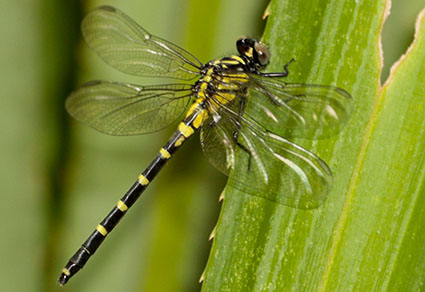Burmagomphus Chaukulensis | 21 Jun 2022
Why in News?
Recently, a rare dragonfly, Burmagomphus chaukulensis was spotted in Kerala.
- Earlier, a new species of dragonfly ‘Platygomphus benritarum’ was discovered in Assam.
What are the Findings?
- This is a dragonfly of genus Burmagomphus, which is represented by three species – B. Cauvericus, B. Pyramidalis and B. Laidlawi.

- While B. laidlawi is found throughout the Western Ghats,
- B. cauvericus is more restricted in its distribution.
- B. pyramidalis is found in the Western Ghats as well as in Peninsular India.
- All other species of the genus are found in the Western and Eastern Himalayas.
- The new species can be separated from its congeners by the markings on the lateral thorax and peculiar shape of anal appendages.
- This species is known to be endemic to the Western Ghats.
What are Dragonflies?
- About:
- It is an aerial predator insect most commonly found near freshwater habitats throughout most of the world.
- Their distinctive colors make them look beautiful. This makes them valuable subjects for research on insect behavior, both for ecology and art.
- Habitat:
- Most species of dragonflies live in the tropics and particularly in the rainforests.
- Significance:
- Dragonflies act as important bio-indicators of the ecological health of an area. As they feed on mosquitoes and other insects that are vectors to life-threatening diseases like Malaria and Dengue.
- Threats:
- The rapid destruction of their habitat poses a direct threat to their survival making their conservation urgent.
UPSC Civil Services Examination, Previous Year Question
Q. The word ‘Denisovan’ is sometimes mentioned in media in reference to (2019)
(a) fossils of a kind of dinosaurs
(b) an early human species
(c) a cave system found in North-East India
(d) a geological period in the history of Indian subcontinent
Ans: (b)
Exp:
- Denisovans are an extinct species of hominid and were close relatives of Neanderthals. They are another population of early human who lived in Asia.
- The Denisovans are a much more recent addition to the human family tree. Paleoanthropologists unearthed a 40,000-year-old adult tooth and an exquisitely preserved fossilized little finger bone that had belonged to a young girl who was between five and seven years old when she died Studies reflects that the girl was closely related to Neanderthals, yet distinct enough to be classified as a new species of archaic humans, which scientists named “Denisovan” after the cave where the bone was found. The Denisovan genome also suggests the young girl had brown hair, eyes, and skin. Therefore, option (b) is the correct answer.
